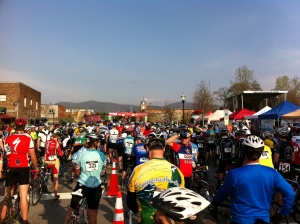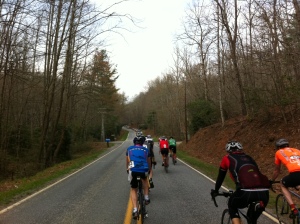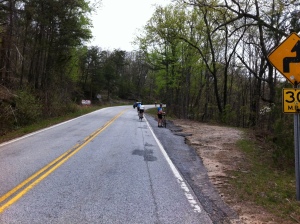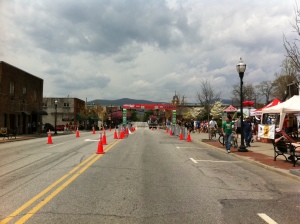This could be viewed as mechanical power - that which needs a power meter to see - and yeah, that's true in a lot of ways, too (as I will discuss below). In truth however, we understand Ben to be saying that a person of great strength of character, leadership, and influence has an obligation to illustrate proper and safe behaviors while upholding his or her duties to the betterment of the group as a whole.
I am reminded of a few training rides we have done in the past year in which certain Pro riders have joined us. The Upstate Winter Bike League had a number of top athletes in the ranks. Sometimes our weekly rides pull in a few Cat 1 racers. On occasion, I've visited other cities and joined in their group rides/events - finding strong riders at every level. In each case, it became evident that there are higher expectations for those riders who have proven themselves in either the sport of racing, in events like the Assaults, or even just the weekly rides.
Note: This is not a discussion about Ride Leaders (organizers) or about individuals appointed to a leadership role. However, those jobs are necessarily imbued with social, ethical, and moral responsibility!
Perhaps it is easier to understand how someone earns the respect of the pack - how one goes about "proving oneself" - rather than trying to dissect the image of one who already has, and here we come to the heart of this posting: With Great Power...
Within the last 2 weeks, I have witnessed both the strength of character and sportsmanship that should be displayed by truly strong and powerful riders. In those same 2 weeks, I saw he exact opposite on display as well (but I will use a ride from last Fall to illustrate the point).
Bruce Humphies is a powerful cyclist, and he is an excellent example of a responsible athlete. When he joins us for our Tuesday night ride, he could easily drop any one of us. Even working together, our Average-Joe crowd probably couldn't chase Bruce down if he wanted to stay away (in fact, the whole Pro1/2 peloton couldn't bridge the gap when Bruce soloed to victory in the SC State Criterium Championships last week). On Tuesdays Bruce sits on the front and pulls, and when we enter an "open zone" with a sprint sign at the end, he attacks - but only so hard as to make us all work. He never leaves the group totally behind - and we all enjoy chasing! After each zone, he waits until we're all together and ready to start the next bit.
Similarly, when we are "neutral" in between these zones, Bruce goes back to setting pace or sitting in, observing the "rules" set out by either the Ride Leader or the tradition of the ride. If someone has a flat or machanical, he waits with the rest of us.
Parker Kyzer is a powerful cyclist. Though young, he is fast becoming a top athlete in the sport, and it is clear that he understands the responsibility that comes with it. Last week, a large group of us rode over Bills Mt and back, following the Assaults course. Again, Parker rode on the front for much of the ride, setting a reasonable pace - and by reasonable, I mean one that allowed for everyone to participate. It was quick, yes - but not impossible and certainly not racing speeds!
On the way back a few riders fell in to difficulty. Some of us were still feeling strong - including Parker - but rather than storming off into the distance, leaving our compatriots to rot in the hot sun, we worked together to come home as a group. But! In order to make the ride a challenge and get a good workout in... Parker pushed the other cyclists who were in trouble! (with their permission, of course)
In this way, he wasn't "wasting time" out there on the road. Both Parker and Bruce do interval training before or after a group ride in which they will be the strongest or fastest guys (which, I surmise, is quite often). OR they do their intervals on a different day. They do not do their intervals during a group ride; a major faux pas!
I was on a group ride last fall, and after a long, casual warm-up, the Ride Leader (Robin Farina) turned back with some of the slower cyclists. She rode the short loop in order to make sure everyone got home safely. Despite the fact that she is a Cat 1, Pro athlete, she rode ~35 miles at 16mph that day.
I remained with the "fast group" on the long course, aiming for ~55 miles. Under the "leadership" of some of the local hammer-heads, the ride quickly devolved into what Chad Andrews calls, a "DS" ride (the second word is "Swinger"... the first, I leave to your imagination). It was fast and vicious. At one point, there were only 2 of us left - the rest had been dropped! Had I not asked for a regroup (and gone back myself), they may never have seen each other again.
Of course, I enjoy racing, and I enjoy the simulation of racing. What surprised me were the dangerous and selfish actions taken by the guys on the front. They didn't regroup (despite it being a group training ride). They didn't stop at traffic signals. They didn't communicate directions or call out road debris and holes. Pushing the limits of a group ride, splintering the group, and shattering the peloton every time you go out... is pointless and unhelpful. Read Paul's blog "the Not-so-good Ol' Days," and my own post "Why We Are Here" for more.
Some people view themselves as "Leaders" who should not. Some people view themselves as strong and powerful riders, though they are not. And in an attempt to illustrate their own self image, they behave poorly
Riding away from a group while the group is "neutral," rolling through stop signs or traffic lights without stopping, failing to regroup at the group's behest, "attacking" (or failing to slow/wait) when others are in difficulty, have a mechanical, are avoiding a dog in the road, or are in some way hampered by road conditions, etc... these actions are unsportsmanlike and shameful. Doing any of these neither impresses the peloton nor proves the strength of the offender. In fact, this kind of behavior sets very bad examples and incites dangerous reactions. Remember, often there are new riders in the pack - and everyone must set a positive examples for the newbies so that they will ride safely and, more importantly, continue to ride.
Like lemmings in spandex, the peloton will blindly follow into self destruction, and it is the duty of those with great power to act with great responsibility!
Please consider all of these points as you ride tomorrow, in the final weeks of Assaults preparations, and in the summer months ahead.
(...and now for the double back-flip, Triple-Lindy, Soapbox Dismount...)
-Peter Kay
http://theAssaults.com
http://TotalCyclist.com
If you are not interested in keeping the group together, then you are not interested in riding with a group. Don't muck-up a good ride by breaking etiquette and riding selfishly.
Fulfill your dreams and ride solo.






